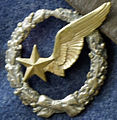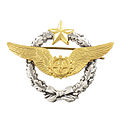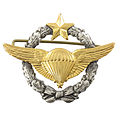Aviator badge
An aviator badge is an insignia used in most of the world's militaries to designate those who have received training and qualification in military aviation. Also known as a pilot's badge, or pilot wings, the aviator badge was first conceived to recognize the training that military aviators receive, as well as provide a means to outwardly differentiate between military pilots and the “foot soldiers” of the regular ground forces.
Austria-Hungary
[edit]Austro-Hungarian Aviation Troops started wearing gilded silver and enameled badges in 1913. The badges style changed after the death of Franz Joseph. In 1917 a new badge was created.
-
Official publication of the Austrian Government in the K. und K. Normalverordnungsblatt Number 2/1913
-
Austro-Hungarian Aviation Troops Badge, 1913 and 1917
-
Austro-Hungarian Aviation Troops Observers Badge, 1917
Belgium
[edit]
The current aviator badge of the Belgian Air Force depicting the Leo Belgicus and surmounted the Royal Crown of Belgium.
Bangladesh
[edit]
Aviator badge of the Bangladesh Air Force[1]
The Aviator Badge of Bangladesh Air Force closely resembles the pilots flying badge of The Royal Air Force. Though the badge has a touch of its own characteristics.
Canada
[edit]The Pilot Flying Badge of the Royal Canadian Air Force is:

China
[edit]The emblem of the People's Liberation Army Air Force is:

Denmark
[edit]
The aviator badge of the Royal Danish Air Force is based on the national coat of arms of Denmark.
Iran
[edit]The Pilot Flying Badge of the Islamic Republic of Iran Air Force is:

France
[edit]The aviator badges of the French Air Force/Armée de l'air française and French Navy/Force maritime de l'aéronautique navale are:
-
Pilot's Badge
-
Observer's Badge
-
Navigator's Badge
-
Flight Doctor's Badge
-
Air Force Flight Nurse
-
Air Force Patient Pilot
-
Naval Pilot's Badge
Germany
[edit]1913-1920
[edit]Several badges were donated to German aircrew prior, during or after the First World War. The most notable were:[2][3]
-
badge for navy pilots from seaplanes 1913
-
badge for observation officers from airplanes 1914
The Military Pilot Badge was donated on January 27, 1913 by Emperor Wilhelm II. It could be awarded to officers, NCOs and crews who, after completing the two required tests for pilots and after completing their training at a military air base, acquired the certificate as a military pilot issued by the military air and land transportation inspection (Inspektion des Militär-Luft- und Kraft-Fahrtwesens). A similar badge for military pilots was donated on 4 February 1913 by Prince Ludwig from Bavaria.
The badge for navy pilots on seaplanes (Abzeichen für Marine Flugzeugführer auf Seeflugzeugen) was donated on 31 May 1913 by King and Emperor Wilhelm II, for all officers and soldiers, who successfully completed the training on a naval aircraft station and thus received a certificate of qualification as a naval pilot.
The badge for navy pilots on land planes (Abzeichen für Marine Flugzeugführer auf Landflugzeugen) was donated on 23 February 1915 by emperor Wilhelm II for pilots of the Navy, who completed their service in the war on land planes.
The badge for observation officers from airplanes (Abzeichen für Beobachtungsoffiziere aus Flugzeugen) was donated on January 27, 1914 by emperor Wilhelm II. Prerequisites for the award were: 1. a distance traveled of at least 1000 km in an aircraft, 2. a successfully completed technical assistance examination on an aircraft, 3. pass of at least one retake, 4. accomplished exploration missions, and 5. a certification as an observation officer. A similar badge was donated by King Ludwig III. on 3 March 1914 for the Bavarian army.
The airgunner badge (Abzeichen Flugzeug-Fliegerschützen) was founded on January 27, 1918 by emperor Wilhelm II. The soldiers had to demonstrate in-depth knowledge in engine construction and operation, in flight training, in map reading, in the tactics of aerial combat, in theory of bombing, and skills in the operation of machine guns on the ground and in aerial combat.
The commemorative badge for airship crews (Erinnerungsabzeichen für Besatzungen der Luftschiffe) was donated in 1920 by Reichswehr Minister Otto Gessler. There were two versions for Army and Navy airships. Upon request, it was awarded to officers, deck officers, NCOs and crews of former airship crews, who during the war had at least one year of activity on front aircraft.
1935-1945
[edit]
The Pilotenabzeichen (Pilot's Badge) of the former Luftwaffe had been instituted by Hermann Göring on 12 August 1935. It came in distinct types; nickel silver (changed to zinc during the war) and a variant made of gold.[4] It depicts a silver eagle perched atop a swastika, wings open in a landing pose, and surrounded by a wreath with laurel on the right side and oak branches on the left side, respectively.[5] It was worn in the center of the left breast pocket of the service tunic, underneath the Iron Cross 1st Class if awarded.[6] The badge was awarded after one completed flight training and the flying licence and citation were received.[5]
After 1955
[edit]
In the Bundeswehr the aviation badge (Tätigkeitsabzeichen Militärluftfahrzeugführer) comes in three grades: bronze (Standard Pilot), silver (Senior Pilot) after 1200 flight hours and gold (Command Pilot) after 1800 flight hours. It depicts the Bundesadler surrounded by an oak leaf wreath between two wings. It is worn above the right breast pocket. A total of two Tätigkeitsabzeichen may be worn, one of which can be foreign in which case the foreign one would be worn below the German one.[7]
Hungary
[edit]1938-1945
[edit]Pilots and navigators of the Royal Hungarian Air Force wore their aviator rating badge sewn on their uniforms right breast above the pocketflap. The Observers Badge was the same, except without the Holy Crown of Hungary. A smaller version of the pilot's badge which was worn on the lower left sleeve of the overcoat - observers also worn a small insignia without the crown on their sleeve.[8] During World War II a gilded bronze pilot and observer badge was also introduced.
 |
 |
 |
After 1990
[edit]After the withdrawal of Soviet forces from Hungary a new Hungarian Air Force was created. It took on the traditions of the Royal Hungarian Air Force. There are 4 classes of pilots badges. Gold laurel 1st class aviator; 1st class aviator, 2nd class aviator, and 3rd class aviator.

 |
 |
 |
Israel
[edit]The current aviator badges ("wings") in the Israel Air Force is:
-
Current badge "wings" of an Israeli Air Force pilot, weapon systems officer, navigator and flight engineer
-
Air Crew chief's Badge
-
Loadmaster's Badge
-
Flight Doctor's and Flight Combat medic's Badge (two versions)
-
AEW&C Operator's Badge
-
Flight test engineer's Badge
-
EW operator's Badge
-
Air Signaller's Badge
-
Air observer's Badge
Namibia
[edit]The aviator badge of the Namibian Air Force is ...
The Netherlands
[edit]The aviator badge of the Royal Netherlands Air Force and the Royal Netherlands Navy is

Pakistan
[edit]The Aviator Badge of the Pakistan Air Force is:

Poland
[edit]The current aviator badge of the Polish Air Force has been in use since the 1920s. The badge is called gapa and represents silver eagle in flight with gold laurel wreath in the bill. Navigator/Observer badge (below) represents the same eagle, but in gold with added lightning bolts. The gapa is worn in the usual place on the upper left breast above the pocket, but unlike other air forces it is suspended on a chain. It adorned the uniform of Polish Air Force officers in the RAF during World War II along with their RAF wings. In the combat version (for at least 7 flights in combat conditions) the badge has a green laurel wreath.
| Badge | Pilot | Observer | |||||
|---|---|---|---|---|---|---|---|
 Air Forces |

|

| |||||
| Pilot | Observer | ||||||
| Abbreviation | pil. | obs. | |||||
Romania
[edit]1912–1931
[edit]The first military aviator badge of Romania was approved by the Ministry of War in 1912, following the establishment of the first pilot school in Cotroceni. It featured a silver miniature of a Blériot XI worn by pilots and observers on the collar of their tunics.[9] In 1915, after the formation of the Romanian Air Corps, new pilot and observer badges were introduced. The pilot badges featured a silver plated royal eagle holding a bomb in its claws and the royal cypher of King Ferdinand I on its chest. Officers wore the metal badges on the left side of the chest while non-commissioned officers wore a silk badge sewn on the left sleeve. From 1919, NCOs were allowed to wear the same badges as the officers. After the death of King Ferdinand, the badge used the cypher of King Michael I until 1931, when King Carol II introduced new badges.[10]
-
Model 1912 aviator badge
-
Model 1915 Romanian pilot badge
1941–present
[edit]At the initiative of General Iosif Iacobici and Air squadron general Gheorghe Jienescu, the military pilot badges, named "war pilot badges", returned to the World War I aspect in 1941 with the difference being the replacement of the royal cypher with the coat of arms of the Kingdom of Romania. After the abdication of King Michael in 1947, the aviator badges were replaced following the Soviet model.[11] During the communist regime, training levels achieved by the pilots were introduced. These levels, classes 1–3, were displayed on the badges in Arabic numerals. In 1977, an initiative launched by some aviators, with support received from Nicu Ceaușescu, youngest child of Nicolae Ceaușescu, brought back the old-style pilot badges. The new badges copied the model 1941 ones, with the coat of arms of the Socialist Republic of Romania shown instead. After 1989, the decision was taken to issue new badges with the center coat of arms replaced by the Romanian cockade due to the lack of a new heraldic emblem. The present Romanian Air Force pilot badges were adopted in 1996.[12][better source needed]
-
Model 1941 pilot badge
-
Current pilot badge, 1st class
South Africa
[edit]The current aviator badge of the South African Air Force has been in use since 2002, when South Africa adopted a new coat of arms. Like the RAF, the SAAF also has a half-wing version of the badge, in this case for navigators. The aviator and navigator badges comes in three grades: bronze, silver and gold. Reserve force aviator badges have a light blue inlay around the coat of arms as appose to the dark blue of permanent air force aviators.
Spain
[edit]Turkey
[edit]
United Kingdom
[edit]The current aviator badge of the Royal Air Force has been in use since the Second World War. The badge consists of a winged crown and wreath, beneath which are the letters "RAF". The Royal Air Force also uses a "half wing" version to denote Weapon System Officers (WSOs) and Weapon System Operators (WSOps) as well as various airborne roles such as Airborne Technician.

United States
[edit]A Military Aviator badge existed from 1912-17 before being replaced by the predecessor of the "wings" badge.

A United States Aviator Badge refers to three types of aviation badges issued by the United States Armed Forces, those being for Air Force, Army, and Naval (to include Marine and Coast Guard) aviation.
Air Force Pilot and Army Aviator Badges are issued in three ratings: Basic, Senior, and Command (Air Force)/Master (Army). The higher degrees are denoted by a star or star with wreath above the badge. Air Force regulations state that the basic rating denotes completion of specified training and that the advanced ratings denote experience levels. The Naval Aviator Badge is issued to pilots upon designation as a Naval Aviator for Navy, Marine Corps, and Coast Guard aviators who successfully complete flight training. There is a single badge design regardless of an individual’s further qualifications.See also
[edit]Notes
[edit]- ^ "Bangladesh Air Force". baf.mil.bd. Retrieved 2021-05-13.
- ^ André Hüsken (2001). Katalog der Orden, Ehrenzeichen und Auszeichnungen des Kurfürstentums Brandenburg, der Markgrafschaften Brandenburg-Ansbach und Brandenburg-Bayreuth, des Königreiches Preußen, der Republik Preußen unter Berücksichtigung des Deutschen Reiches / 3, Ehrenzeichen, Auszeichnungen und Ehrengaben 1888-1935. Bremen: Hauschild. ISBN 3897571382. OCLC 314298345.
- ^ Nimmergut, Jörg. (2001). Deutsche Orden und Ehrenzeichen bis 1945 / 4 Württemberg II - Deutsches Reich. München: Zentralstelle für wiss. Ordenskunde. ISBN 3000013962. OCLC 163184635.
- ^ Ailsby 2003, pp. 59, 60.
- ^ a b Ailsby 2003, p. 59.
- ^ Angolia 1987, p. 162.
- ^ ZDv 37/10 Anzugordnung für die Bundeswehr
- ^ "Shaw Communications" (PDF).
- ^ Valeriu Avram (2013). "Din Istoria Aripilor Românești 1910-1916" (PDF). Buletinul Arhivelor Militare Române (in Romanian). No. 61/2013. p. 6. ISSN 1454-0924.
- ^ Lazar & Stambuliu 2016, pp. 80, 82.
- ^ Lazar & Stambuliu 2016, p. 86.
- ^ "Insigne din Aeronautica Română". Retrieved 20 December 2024.
References
[edit]- Ailsby, Christopher (2003) [1994]. A Collector's Guide To: World War 2 German Medals and Political Awards. Ian Allan Publishing, Inc. ISBN 9780711021464.
- Angolia, John (1987). For Führer and Fatherland: Military Awards of the Third Reich. R. James Bender Publishing. ISBN 0912138149.
- Lazar, Adrian; Stambuliu, Bogdan (2016). Military and sociopolitical badges of Romania 1859-1947. Bucharest: Galeria Numismatica.





























